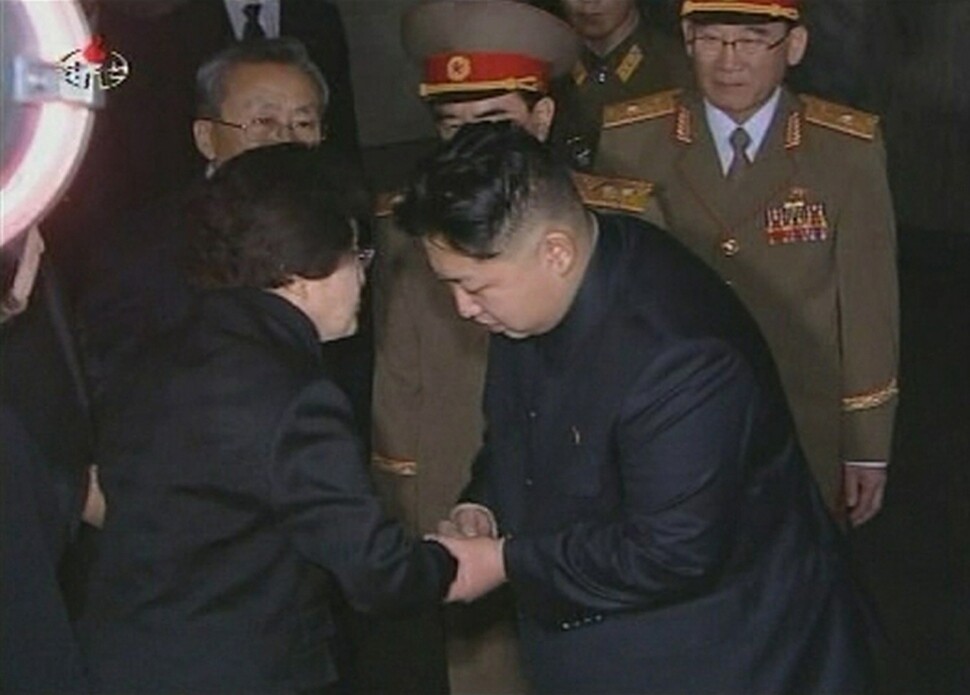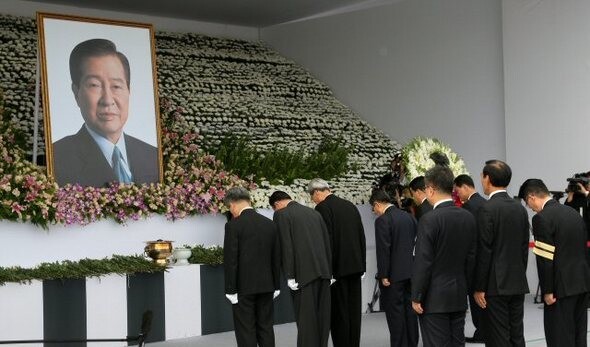hankyoreh
Links to other country sites 다른 나라 사이트 링크
Observers speculate over effect of Lee Hee-ho’s death on inter-Korean relations

The late Lee Hee-ho, chair of the Kim Dae-jung Peace Center, dedicated her life to women’s rights, democratization, and peace on the Korean Peninsula, and some speculate that even her passing could help further inter-Korean dialogue. If North Korean leader Kim Jong-un sends a delegation of high-ranking officials to South Korea to pay their condolences, it could lead to high-level dialogue between the two sides and a possible breakthrough in the current impasse. At the request of the committee in charge of organizing Lee’s funeral, South Korea’s Unification Ministry communicated the news of her death to North Korea via the Inter-Korean Liaison Office on the morning of June 11.
Lee Hee-ho had deep ties with North Korea, being the first South Korean public figure to personally meet Kim Jong-un. When former North Korean leader Kim Jong-il passed away in December 2011, Lee visited the Kumsusan Memorial Palace (today called the Kumsusan Palace of the Sun) to personally convey her condolences. Kim Jong-un expressed his gratitude to Lee for making the long journey and treated her with the utmost courtesy, arranging for her to stay in the Paekhwawon State Guest House, which was the site of the first inter-Korean summit in 2000, between Lee’s late husband Kim Dae-jung and Kim Jong-il. Lee made another visit to North Korea in August 2015 on Kim Jong-un’s invitation, but the two did not meet on that occasion because of political tensions.
Considering the role Lee played in bringing peace to the Korean Peninsula and her connection to Kim Jong-un, many think that North Korea is quite likely to dispatch a high-level delegation to offer their condolences. But North Korea’s recent pressure on South Korea to come up with a “solution to the fundamental issue” has also fueled the more pessimistic view that the North will be reluctant to send a delegation that’s expected to engage in high-level dialogue. “It’s too soon to say,” said an official from the Unification Ministry.

Even if North Korea sends a high-ranking delegation, the members of the delegation would probably be unable to pay a courtesy call on South Korean President Moon Jae-in. Lee’s funeral procession will be held on the morning of June 14, and Moon, who is currently on a tour of three countries in Northern Europe, is planning to return to South Korea around noon on June 16.
After former President Kim Dae-jung passed away on Aug. 18, 2009, Kim Ki-nam, secretary of the Central Committee of the Workers’ Party of North Korea (WPK), and Kim Yang-gon, director of the WPK’s United Front Department, visited South Korea to express their condolences and paid a courtesy call to then President Lee Myung-bak during their visit. North Korea sent its first delegation of this kind upon the death of Chung Ju-yung, founder of the Hyundai Group, on Mar. 21, 2001. One of the members of that delegation was Song Ho-gyong, vice chairman of the Korea-Asia-Pacific Peace Committee.
Upon the death of former President Roh Moo-hyun on May 23, 2009, North Korea sent a telegram of condolence signed by Kim Jong-il instead of a delegation. That was widely understood to have been affected by the worsening political environment, since North Korea’s second nuclear test took place just two days later, on May 25.
By Noh Ji-won, staff reporter, and Lee Je-hun, senior staff writer
Please direct comments or questions to [english@hani.co.kr]

Editorial・opinion
![[Column] Has Korea, too, crossed the Rubicon on China? [Column] Has Korea, too, crossed the Rubicon on China?](https://flexible.img.hani.co.kr/flexible/normal/500/300/imgdb/original/2024/0419/9317135153409185.jpg) [Column] Has Korea, too, crossed the Rubicon on China?
[Column] Has Korea, too, crossed the Rubicon on China?![[Correspondent’s column] In Japan’s alliance with US, echoes of its past alliances with UK [Correspondent’s column] In Japan’s alliance with US, echoes of its past alliances with UK](https://flexible.img.hani.co.kr/flexible/normal/500/300/imgdb/original/2024/0419/2317135166563519.jpg) [Correspondent’s column] In Japan’s alliance with US, echoes of its past alliances with UK
[Correspondent’s column] In Japan’s alliance with US, echoes of its past alliances with UK- [Editorial] Does Yoon think the Korean public is wrong?
- [Editorial] As it bolsters its alliance with US, Japan must be accountable for past
- [Guest essay] Amending the Constitution is Yoon’s key to leaving office in public’s good graces
- [Editorial] 10 years on, lessons of Sewol tragedy must never be forgotten
- [Column] A death blow to Korea’s prosecutor politics
- [Correspondent’s column] The US and the end of Japanese pacifism
- [Guest essay] How Korea turned its trainee doctors into monsters
- [Guest essay] As someone who helped forge Seoul-Moscow ties, their status today troubles me
Most viewed articles
- 1[Column] The clock is ticking for Korea’s first lady
- 2After 2 months of delayed, denied medical care, Koreans worry worst may be yet to come
- 3US overtakes China as Korea’s top export market, prompting trade sanction jitters
- 4[Column] Has Korea, too, crossed the Rubicon on China?
- 5[Correspondent’s column] In Japan’s alliance with US, echoes of its past alliances with UK
- 6Hong Se-hwa, voice for tolerance whose memoir of exile touched a chord, dies at 76
- 7[Editorial] When the choice is kids or career, Korea will never overcome birth rate woes
- 8Samsung barricades office as unionized workers strike for better conditions
- 9All eyes on Xiaomi after it pulls off EV that Apple couldn’t
- 10More South Koreans, particularly the young, are leaving their religions